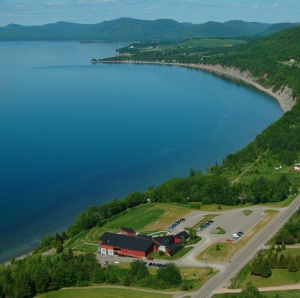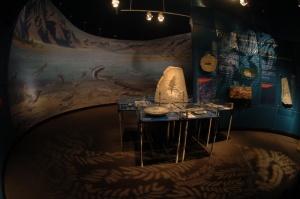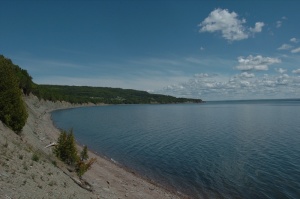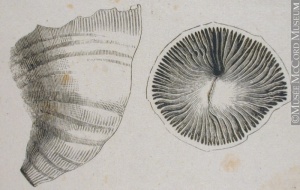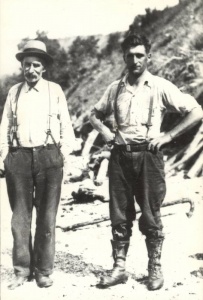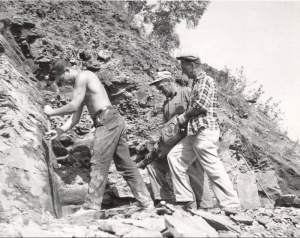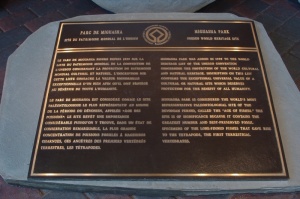Parc national de Miguasha
par Charest, France
Parc national de Miguasha is one of the world’s most prestigious fossiliferous sites. Thousands of fossils of fish, plants, and invertebrates some 380 million years old have been discovered there. UNESCO added this natural site on the Gaspé Peninsula to its World Heritage List on 4 December 1999. But well before being recognized as a world treasure, this site had long been a part of the daily life of the inhabitants of Miguasha who collected fossils. Indeed, these people were tremendously helpful to the scientists who began to appear in their region at the beginning of the 20th century. Scientists still take an active interest in the site, and the park’s team of paleontological researchers continue to gather new specimens from the now-famous cliff. Some of these marvellous fossils are on display in the permanent exhibition of the Miguasha Museum of Natural History located on the very site where they were discovered!
Article disponible en français : Parc national de Miguasha
The Miguasha Museum of Natural History
Few fossiliferous sites have the
opportunity to exhibit their star pieces in a museum located right on the site
where they were discovered. The
Miguasha Museum of Natural History (Musée d'histoire naturelle de Miguasha), a stone’s throw away from the fossiliferous cliff,
is one of the lucky few. Visitors to the museum can learn about the fossils,
including how they were discovered and how they were organized in a collection,
while enjoying an introductory overview of the scientific research carried out
on these fossils.
At the heart of this museum, which was expanded and renovated in 2002–2003, lies
the exhibition room where the fossiliferous treasures are presented to their
best advantage in a modular exhibition that can be updated and modified to stay
in tune with the ongoing research carried out on the site. Visitors are thus
apprised of new discoveries shortly after they are unearthed. The exhibition includes
a variety of sections on such topics as the Miguasha paleoenvironment, the
fossilization process, the human history of the area, research projects and of
course the different fossil species that lived here some 380 million years ago.
The museum is also equipped with a research centre made up of three collection
rooms, two fossil preparation labs, a darkroom and a research room. The main
collection, also called the “national collection,” boasts over 9,000 fish fossils, some
1000 plant specimens, and several dozen invertebrate specimens (90 at this
writing). As for the stratigraphic collection, it contains thousands of fossil
specimens that help to reconstitute the history of the Gaspé Peninsula and Quebec through different geological periods. And finally, type specimens collection was
designed to house all specimens that have served as references in scientific
publications.
Every summer, the park’s research staff carry out digs on this exceptional
fossiliferous site. These digs aim to unearth new specimens or, better still,
new species, and to give scientists a better understanding of the Miguasha paleoenvironment.
In addition, members of research staff collaborate from year to year with
paleontologists around the world who either borrow specimens or come to the
site to do their research.
Miguasha’s Geological Heritage
The territory encompassed by Parc national de Miguasha is a narrow strip of land two kilometres long that runs along the coast and covers less than one square kilometre. It is on the western side of Miguasha Point, on the Gaspé Peninsula. This hilly point of land, which separates the fresh water of the Ristigouche River from the salt water in Chaleur Bay, is known for its beautiful landscapes.
The geological
history of the Miguasha cliff is closely related to that of the Appalachian
Mountains, which were formed about 400 million years ago during the Devonian geological
period (from 416 million to 359 million years ago). The sediment that makes up
the cliff is the product of the erosion of these once-gargantuan mountains. At
that time, sediment was carried by rivers and streams. Over time, the deposits
of sediment built up and were compacted into a vast paleoestuary. The fish,
plants and invertebrates that lived in or around this estuary were part of this
slow process. The sedimentary and fossiliferous layers, initially horizontal,
have since undergone a series of morphological changes caused by the effect of
tectonic forces exerted on the Earth’s crust. The resulting geological
formation was called the Escuminac Formation. Its layers of sandstone and argillaceous
rock are exposed in a cliff that now stands some 30 metres above the
present-day level of the estuary.
A second formation—the Fleurant Formation—is also exposed in some places on the
Miguasha cliff. The Fleurant Formation, which predates the Escuminac Formation,
and therefore lies beneath it, is a conglomerate—that is, an assemblage of
pebbles of various sizes held together by sand. This formation was likely the
bed of an ancient river with a high rate of flow that probably predated the
more gently flowing paleoestuary.
Although it does not lie within the boundaries of the park, the Bonaventure Formation adds to the charm of Miguasha Point with its surprisingly flamboyant dashes of red. This formation, exposed at several spots along the cliff—as well as elsewhere on the south coast of the Gaspé Peninsula—is a conglomerate from the Carboniferous Period (359 to 299 million years ago). Its red colour, resulting from oxidation of the iron contained in the sediment, is what gave Miguasha its name, Miguasha being derived from the Mi'kmaq word megwasag, meaning red earth or red cliff.
Miguasha and Quebec’s Scientific Heritage
For over 100
years, from 1879 into the 1980s, as many as 8,000 fossils were gathered from
the park’s current location then studied in various museum-related and academic
facilities around the world, where they are still kept. Scores of important
articles have been written by foreign scientists on the fossils of Miguasha.
With the creation of a conservation park in the 1980s, the site became a hub
for research activity and was no longer simply the place where specimens were
gathered. Creation of the park meant that all fossils would henceforth be
preserved at Miguasha, and foreign establishments, such as universities and
museums, would have to work with the park’s staff in order to gain access to
the site. This new way of doing things has been the basis for numerous international
collaborations involving park research staff and researchers from all over the
world. These collaborative endeavours have provided opportunities to train a
whole new generation of Quebecois palaeontologists who are at last able to take
an active part in research activity.
There are very few universities in Canada that offer studies in paleontology.
In Quebec, the only existing program is a Canada Research Chair in Vertebrate
Paleontology at McGill University. For this reason, the majority of Quebecois
palaeontologists were trained in the United States or Europe. However, there is
a project underway involving a favoured-partners arrangement between Parc national de Miguasha and L’Université
du Québec at Rimouski, which will foster research carried out in Quebec by
French-speaking students. A brand new generation of paleontologists is already
being trained, laying the way for a bright future for Quebec-based
paleontological research. This promises to yield a dynamic and diversified body
of research that ranks among the world’s best, and Quebec will thus be in a
position to have a greater impact in the field of paleontological research
internationally.
Discoveries of the Miguasha Site
Before the
first European settlers arrived in the 18th century, Miguasha Point
was a crossing point for the Mi'kmaqs, a nomadic aboriginal people that
frequented the area. The British were the first to establish a European
presence in Miguasha following the 1760 Conquest. Then, in 1855, the abolition of
the seigniorial system provided favourable conditions for many Acadians to
settle in the area.
The earliest discovery of fossils in Miguasha was made in 1842 by New Brunswick
provincial geologist Dr. Abraham Gesner. Despite its inclusion in a report,
this discovery fell away into obscurity. Miguasha gained renown, not with the
1842 discovery, but rather, when the site was rediscovered in 1879 by Robert W.
Ells, a geologist for the Geological Survey of Canada. The first organized digs
took place in the years that followed, and the first writings describing the
fossils of Miguasha were published in 1880–1882. Following these publications, many
teams of scientists came from Europe and the United States to gather thousands
of specimens, which are now preserved in museums around the world.
Local Collectors
The first scientists who had come to take samples were welcomed by families in Miguasha, among them the Plourde family. Antoine Plourde, who was 19 at the time of the 1879 discovery, guided foreign scientists to the cliff’s richest fossil layers. He even guided a group of scientists during the 12th International Geological Congress in 1913. On this occasion, he had set out his finest specimens on tables on the beach. They went like hotcakes! By this time, Antoine’s son Euclide Plourde had also developed a passion for the cliff and its fossils, and he took part in the digs alongside the scientists.
Another family, the Landrys, offered room and board to visiting scientists for a dollar a day. They also collaborated with the scientists on research. Indeed, it was Mr. Joseph Landry who sold one of the most exceptional specimens of the species Eusthenopteron foordi, also known as the Prince of Miguasha, to the scientists of the Swedish Museum of Natural History in Stockholm (Sweden). This specimen, preserved in three dimensions, which was sold for $50 in 1925, was studied for 25 years and yielded many discoveries on the anatomy of this species.
The Quebecois Discovery
It was not until 1937 that Quebeckers who were not residents of Miguasha—namely Léo-Georges Morin of l'Université de Montréal and Reverend J.W. Laverdière of Laval University in Quebec City, both geologists—visited the site. Upon their arrival in Miguasha, they were intrigued by a sign offering “Fossils for sale,” which led them to the Plourde family home. These two academics then learned that the site was the summer destination of several foreign scientists. They immediately notified Quebec provincial government officials, and René Bureau, who was at that time a technician for Quebec’s Department of Natural Resources (now called the Ministère des Ressources naturelles et de la faune), was given the mandate to compile the first Quebecois collection of Miguasha fossils. During his expeditions to the site, Mr. Bureau received help from Joseph Landry, who provided him with a place to stay, and Euclide Plourde, who acted as his assistant and guide.
Actions Taken to Protect and Enhance Miguasha Fossils—1937 to Present
René Bureau lost no time in issuing recommendations on how best to preserve the Miguasha fossiliferous site. However, with the outbreak of World War II, the government’s priorities quickly shifted. Mr. Bureau was not to renew his efforts to achieve protected status for the site until the 1960s. In 1972, land adjacent to the cliff was purchased at last, thanks to a joint effort by Mr. Bureau and Quebec’s department of tourism, hunting and fisheries (Ministère du Tourisme, de la Chasse et de la Pêche). In 1975–1976, management of the site was entrusted to l'Université du Québec at Rimouski, whereupon a team came to gather specimens for the purpose of establishing a collection. Responsibility for managing the site was returned to the ministry in 1977. At this time, Marius Arsenault, who was completing a master’s degree in paleontology, was appointed head of a new team that gathered newly unearthed fossils and established an interpretive facility. The first museum, then, opened its doors in June 1978, thanks to a concerted effort by Mr. Arsenault’s team, René Bureau and a citizen committee. Henceforth, guided tours of the exhibition and the cliff were available to visitors. These guided tours have become a tradition and are available to the general public to this day!
In 1985, the
concerted efforts to establish a conservation park finally came to fruition,
and the importance of this fossiliferous site in the natural heritage of Quebec
was thus officially recognized.
Subsequently, in 1991, the museum underwent an expansion, which included
the addition of an initial official collection room, where fossil samples taken
from Miguasha since 1975 were repatriated to be housed in a single location. In
the same year, the 7th International Symposium on Early and Lower
Vertebrates, an event of international importance, was held in the new museum.
There was still one major accomplishment that remained to be realized: the
park’s inclusion in the UNESCO list of World Heritage sites. This idea had been
tossed around since the late 1970s, for Marius Arsenault, the park’s director
from 1977 to 2003, remained convinced that the site was worthy of this
distinction. Indeed, he was one of
the first people to take an active interest in the file. Creation of the conservation
park was a crucial prerequisite, but there was still much work to do and many
people to persuade. For a fossiliferous site to be included on the list, it
must be shown to be objectively the best such site in the world for the fossils
of a particular geological period. A sweeping study was therefore undertaken by
two paleontologists—Dr. Richard Cloutier, from Quebec, and Dr. Hervé Lelièvre, from
France—to compare some 15 important fossiliferous sites representing the
Devonian period, according to a new set of criteria set forth by the International
Union for Conservation of Nature (IUCN) and UNESCO. This study showed that the
Miguasha fossiliferous site stood out from all of the other Devonian sites.
This considerable effort led to registration of Parc national de Miguasha as a UNESCO
World Heritage natural site on December 4, 1999. Since this time, the park and
the museum have continued to grow and to attract ever-increasing numbers of
visitors. In 2007, one of the first individuals to have worked to protect the
site was honoured when the famous fossiliferous cliff at Miguasha was
officially named Falaise René-Bureau.
Efforts to protect the site, undertaken as early as 1937, contributed
ultimately to preserving this unique treasure of our natural heritage for
present and future generations. The park’s current staff continue to work with
unflagging passion to protect this exceptional site and to present it in its
best light, accomplishing this through their research and through updates and
improvements to the outreach and education program made available to the
approximately 24,000 people who visit the site each year.
France Charest
Co-Manager of Conservation and Research
Parc national de Miguasha
Bibliography
Cloutier, Richard et Hervé Lelièvre, Étude comparative des sites fossilifères du Dévonien, Ministère de l'Environnement et de la Faune du Gouvernement du Québec, 1998, 88 p.
Cloutier, Richard, Le parc de Miguasha : De l'eau à la terre, Publications MNH Inc., Collection In Situ 3, 2001, 143 p.
Cournoyer, Raymond, Parc de Miguasha : Le plan directeur, Ministère de l'Environnement et de la Faune du Gouvernement du Québec, Direction des parcs québécois, 1998, 88 p.
Schultze, Hans-Peter et Richard Cloutier (Éds), Devonian Fishes and Plants of Miguasha, Quebec, Canada, Verlag Dr. Friedrich Pfeil, München, 1996, 374 p.
«De l'eau à la terre : Le parc national de Miguasha», Société des établissements de plein-air du Québec (SEPAQ), site consulté le 23/04/09 [en ligne], http://www.sepaq.com/pq/mig/miguasha/
Additional DocumentsSome documents require an additional plugin to be consulted
Images
-
 Antoine Plourde et so
Antoine Plourde et so
n fils Euclide ... -
Certaines roches argi
leuses de la fo... -
Coup d’œil sur l’expo
sition permanen... -
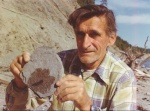 Euclide Plourde en 19
Euclide Plourde en 19
76. Il est rest...
-
 Gravure d'un fossile
Gravure d'un fossile
-
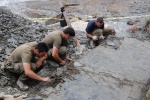 L’équipe de fouille à
L’équipe de fouille à
l’œuvre!... -
La collection nationa
le avec ses cab... -
La falaise fossilifèr
e de Miguasha e...
-
La plaque dévoilée en
juillet 2000 p... -
La visite guidée de l
’exposition per... -
Le musée d’histoire n
aturelle de Mig... -
Le musée d’histoire n
aturelle de Mig...
-
Le musée d’histoire n
aturelle de Mig... -
Le pavillon d’accueil
du musée d’his... -
 Le premier musée, ouv
Le premier musée, ouv
ert en 1978 -
Le travail du prépara
teur, qui netto...
-
Les fouilleurs au tra
vail -
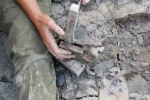 Lors des fouilles, ce
Lors des fouilles, ce
rtaines roches ... -
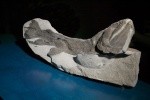 Moulage d’un spécimen
Moulage d’un spécimen
3D de l’Eusthe... -
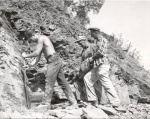 René Bureau (droite)
René Bureau (droite)
accompagné de E...
-
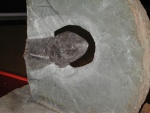 Un magnifique spécime
Un magnifique spécime
n 3D de l’Eusth... -
Un site de fouilles s
ystématiques où... -
Vue aérienne du musée
d’histoire nat...

